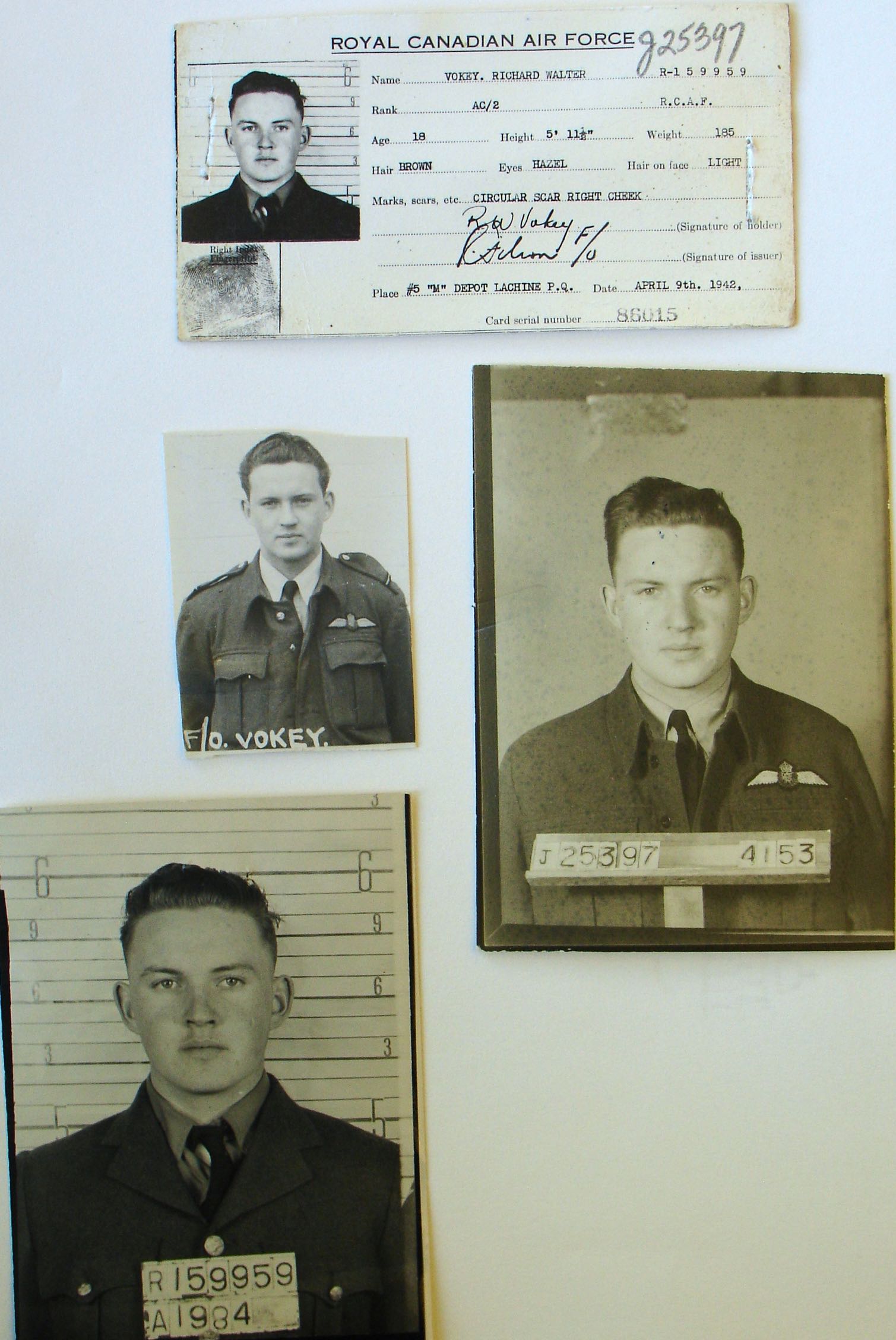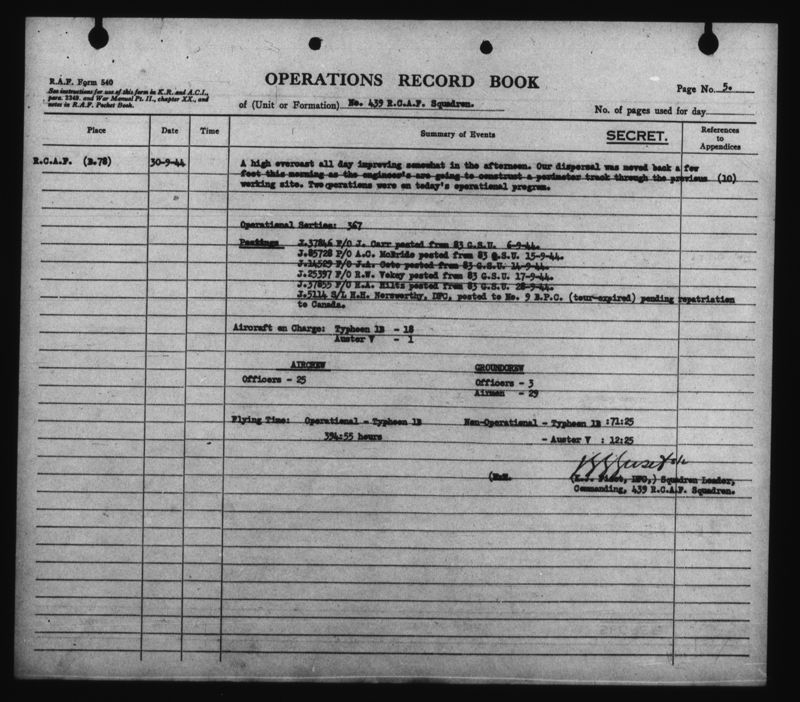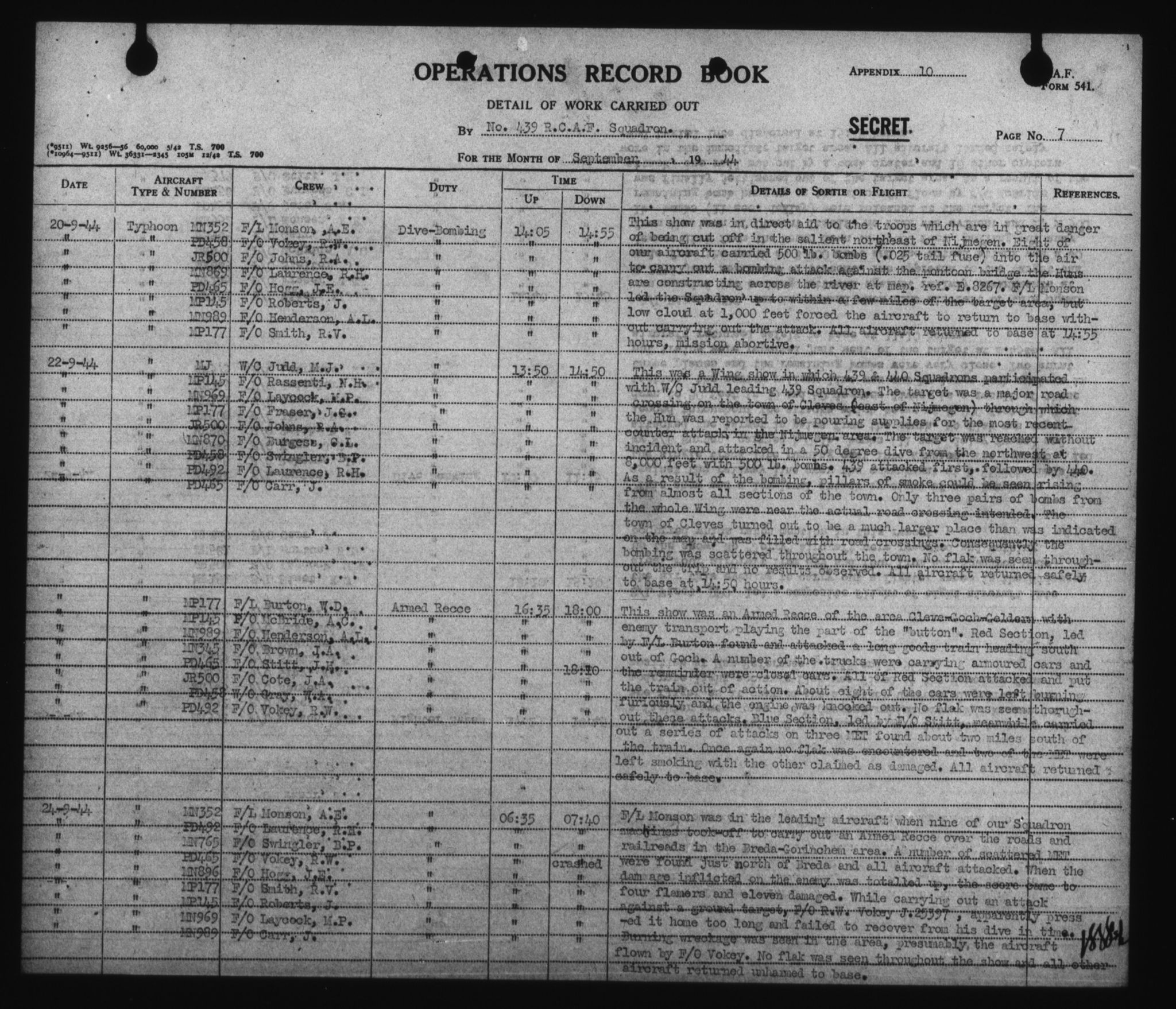


1923 (Approximate) - September 24, 1944



Richard Walter Vokey was the son of John Philip and Catherine Vokey of Montreal, Quebec. He had five brothers. The family attended the Church of England. Vokey was a draughtsman with Dominion Bridge Co. as of September 1941. He had his tonsils removed prior to enlistment.
In January 1942, he was being assessed as a candidate for the RCAF. "Good physical condition, but overweight. I think this condition will be remedied with drilling," wrote the MO. "He is very anxious to fly, intelligent, pleasant and cooperative." Additional comments by the Interviewing Officer: "Keen to fly, good marks in maths, health has been uniformly good, can drive a car. Active participation in sports, particularly swimming, keen, alert, quiet, intelligent reponse. Anxious to fight and fly. Expressed desire to be a fighter pilot. Recommendable." By April 1942, he was ready to start his training through the BCATP.
Vokey was at No. 5 AFU from July 20, 1943 to November 21, 1943. "Not suitable at all for a flying instructor. Trained in Canada. Average pilot. Navigation satisfactory. Formation steady and holds good position. Night flying only fair. As an officer, he shows good qualities and should lead well on operations, though he has a tendency to be overconfident."
On September 24, 1944, S/L Fiset wrote to Mr. Vokey, "439 Squadron was detailed to carry out an armed reconnaissance over enemy territory. On approaching the target area, the squadron broke up into pre-arranged sections and began seeking out their own individual targets. Your son was flying No. 2 man [in Typhoon PD465] on the section leader and they began their initial attack on a concentration of enemy vehicles. Considerable flak was encountered and your son's aircraft must have been hit, for when the No. 1 leader turned, there was no trace of Dick, nor his aircraft. There was a certain amount of wreckage on the ground, but no one had seen Dick bale out. It is rather difficult to express sympathy at a time like this, but on behalf of all pilots of this Squadron and myself, I wish to offer our sincerest sympathies to you and your family. Dick had just joined our Squadron about two weeks prior to his accident and was rapidly becoming 'at home' with us. His operational tour was just commencing and he was starting to show that with experience, he would be one of the leading pilots of our Squadron."
Ten months later, in July 1945, F/L T. W. Leary, 226 Squadron was the investigator on the search for Typhoon PD465. "I proceeded to [Keizersveer] and questioned the policeman there. He stated that he had not heard of any aircraft coming down in his area in September 1944. The River Pilot at Keizersveer said that an aircraft had been found by a farmer Swarts in his field at Drongelen. I questioned Swarts and he showed me the remains of a body and aircraft in his field which he had found when haymaking on July 4, 1945; previous to that date, the area had been flooded and evacuated up to March 1945. On examination, I found that the body had some airman's clothing attached to it and the only means of identification was a neckband of the shirt which contained the initials 'KC' and an indecipherable laundry mark stamped on it. In the same field, I found the empanage of a Mitchell aircraft Serial No. HD 990 and a Vickers gun, Serial No. 1284950, also the remains of a parachute harness No. 01418. Scattered over the field were other parts of the same aircraft. No part of the aircraft showed Squadron markings. Farmer Swarts knew nothing about a Typhoon aircraft in that area. I next interviewed the policeman at EETHAN: Willen Van der Pol who is responsible for the Drongelen area. He stated that two bodies from the aircraft had been buried in Drongelen cemetery. The names of the dead were H. M. Shaw and Sgt. Grice. He took me to the Town Hall and gave me a wristlet watch with the name of H. M. Shaw and the number B.119052 engraved on the back, also a F.441 which had a flight plan filled in showing the Squadron No 98 and G.H. Operator Sgt. Grice. Policeman Van der Pol knew nothing about a single seater aircraft crashing and burning in the area but referred me to the Burgomaster at Waalwijk. He did not know anything about a Typhoon aircraft but said that the people at Elshout might know since they had remained in their village during the fighting in that area. M. J. Van der Wiel, shoemaker at Elshout, took me to a pool near a river bank and showed me part of an aircraft wing. Attached to the wing were three metal plates which I removed. One gave the type of the aircraft as a Typhoon, Serial Number G5/213246; the other two described the 'inner wing flap starboard Serial No. /41H/56. This was the only method of identifying the aircraft part. This shoemaker said that the other parts of the airframe had been taken away by various people from the villages in the area. After further questioning, he led me to an engine which I identified as a Sabre engine by a nameplate on the plughead sleeve. I could not find the Serial number of the engine since it was scarred by burning and the propeller was deeply embedded in the ground. Cornelia Van Delft of Elshout says she saw this aircraft shot down on the 24th of September 1944 at 1503 hours when it was attacking a bridge at Heusden. The pilot descended by parachute and was taken prisoner by a German Parachute Company. She gave a description of the pilot as height 6', hair black, and a moustache. He was not wounded, but since he was wearing a flying suit, she could not give me any idea of his rank. The pilot stayed one night at the house of Harry Pulles in Elshout, under German guard, but was not allowed to speak to the Dutchman. Police says he was taken away next morning on a bicycle. I was assisted on this investigation by Sgt. Jones, RAFP and a Dutch interpreter." Who was this pilot?
The MR&E Unit continued to investigate Vokey's crash some time afterwards. Mr. Braat of Breda was interviewed and he confirmed the scene of the crash, confirming F/O Vokey's section. The aircraft had a large letter "V" and the number PD465, which confirmed the Typhoon was the one Vokey had been flying. Vokey had originally been buried at the scene by members of the underground and was exhumed in October 1945 by a Canadian Officer. For some time, Vokey's grave was marked Unknown RCAF, September 1944. It was suggested by the investigator, that contact be made with the Canadian GCU, who had already left Holland, as to whether the body was the one removed from the crash near Keizersveer. He indicated that it was the only grave marked Unknown for the month of September 1944.
A watch was recovered from Vokey's body, with the name and number of Cpl Hedley M. Shaw, Lake Superior Reg. In October 1945, the Air Ministry concluded, "The presence of the watch in the aircraft cannot be understood and the only logical conclusion seems to be that it was sold by Shaw to a member of the RAF." Shaw died February 11, 1945. Grice died August 4, 1944. Another mystery.
LINKS: